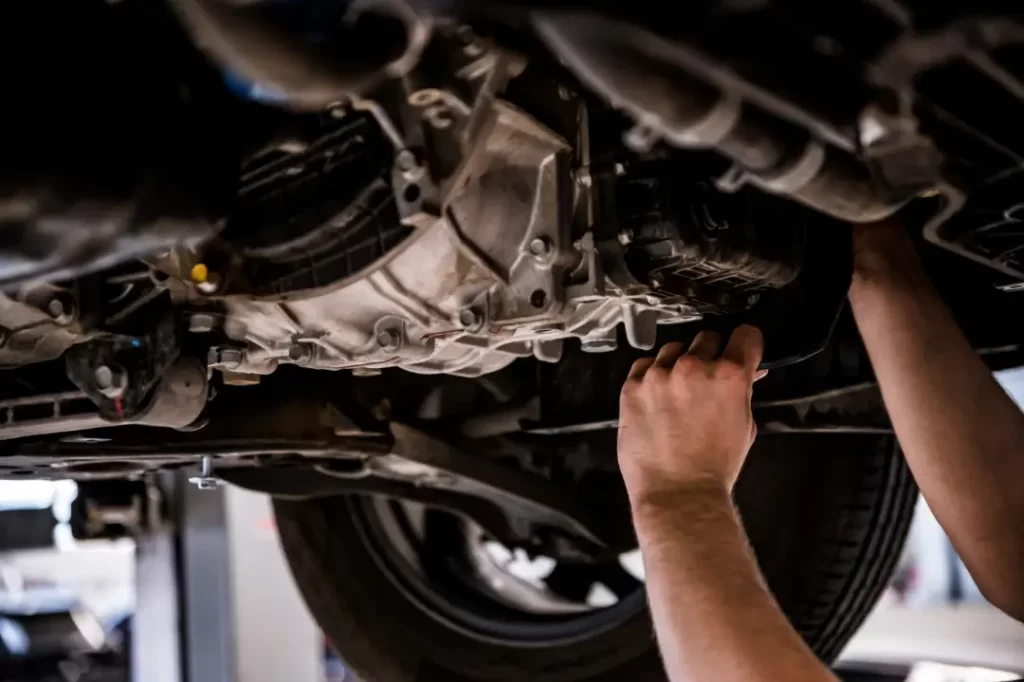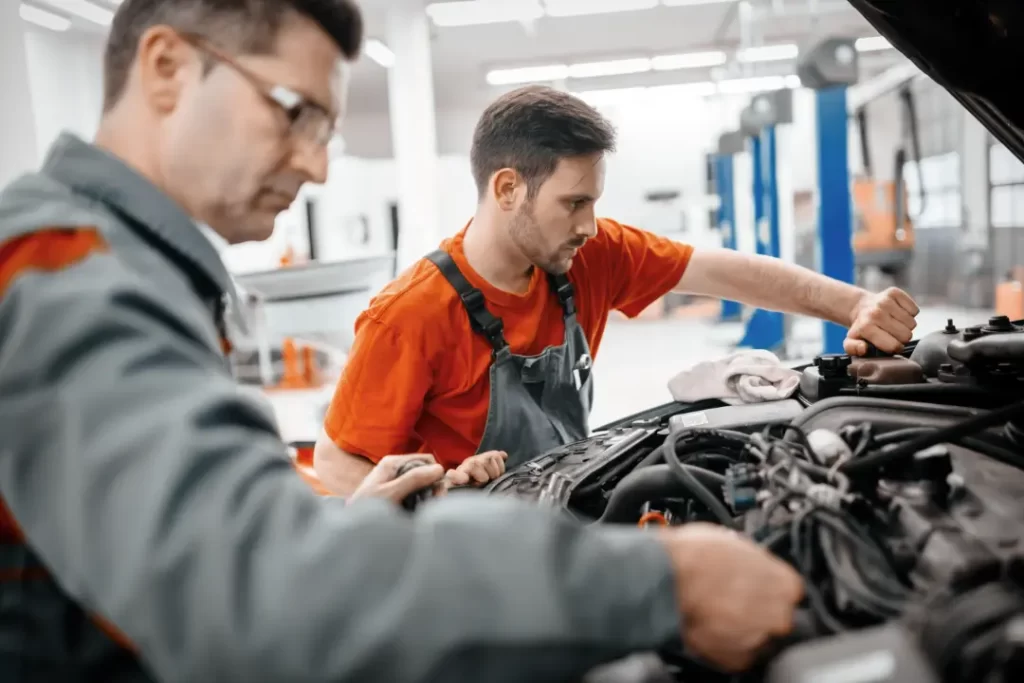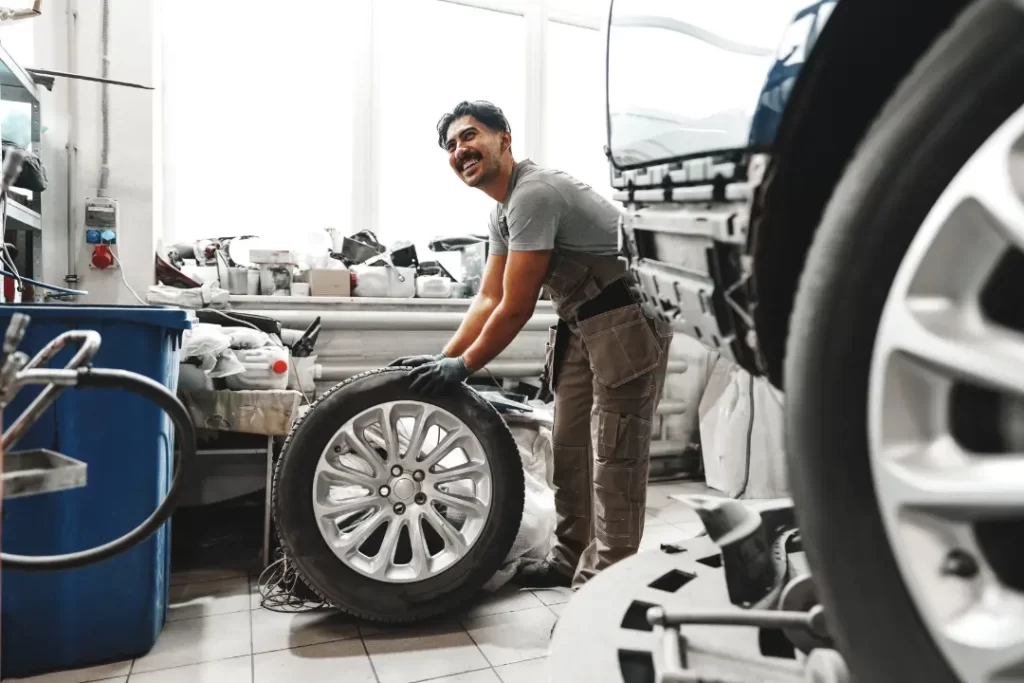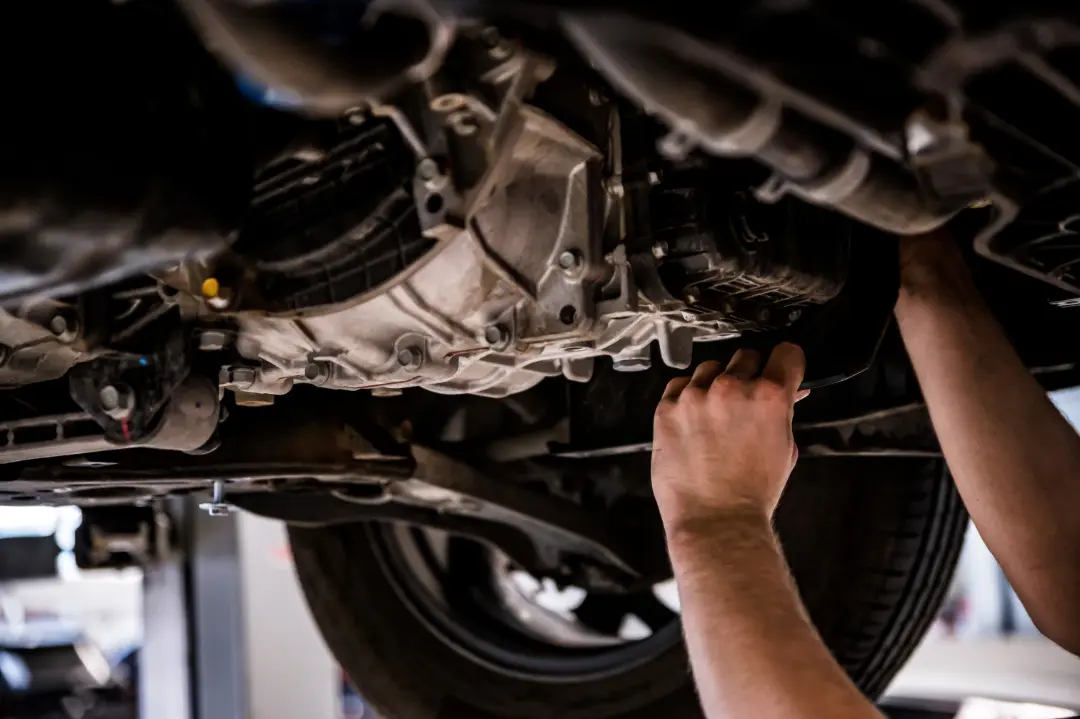What does an MOT check entail for your vehicle? An MOT is a mandatory annual inspection for vehicles over three years old to ensure roadworthiness, safety, and environmental compliance. The test examines critical components like brakes, lights, and exhaust systems, identifying issues that may require attention. Using an MOT checklist can significantly increase the chances of passing the test on the first attempt. Keep reading to uncover all the essentials of an MOT check.
Key Takeaways
- The MOT test is an annual mandatory examination for vehicles over three years old in the UK, scrutinising various safety and emission aspects to ensure roadworthiness, including brakes, lights, exhaust system, and vehicle structure.
- Vehicle owners should prepare for the MOT test by checking and maintaining key components such as fluid levels, tyres, lights, and brakes to avoid common failure points and ensure a greater likelihood of passing the test.
- Post-MOT, a vehicle might pass with advisories, fail with minor or major faults, or receive a dangerous failure rating; any faults should be repaired promptly with options for a free partial retest within a preset timeframe or a full retest for delayed or additional repairs.
Understanding MOT Tests
The MOT test, required once a vehicle reaches three years old, must be retested yearly on the anniversary of its last MOT. Why does your vehicle need an annual MOT test? Think of the MOT test as a comprehensive health check for your car. It’s an opportunity to catch potential problems early and fix them before they escalate into more serious (and potentially expensive) issues.
Securing a valid MOT certificate is only part of the story. Maintaining your vehicle well after obtaining the MOT test certificate is equally important. This ensures better vehicle performance and safety on the road. Similar to regular health check-ups, early identification of potential issues during the MOT test allows for timely repairs before they escalate into major problems. Neglecting routine maintenance, such as cambelt replacement, can lead to serious engine damage and potential MOT failures.
Key Components Checked During an MOT Test
The MOT checks various safety and emission components of a vehicle to ensure it meets the legal standards for roadworthiness. This includes examining:
- Brakes
- Lights
- Exhaust system
- The vehicle’s body and structure to ensure they are free from excessive corrosion damage and have no sharp edges that can cause injury
- Doors, including the bonnet and tailgate, for secure latching in the closed position
- Mirrors for presence, condition, and security
The MOT test also checks the functionality and security of rear doors to ensure safe exit and entry for passengers. In addition, indirect vision devices like mirrors and camera systems must be present, properly aligned, and free from damage to ensure optimal visibility.
All these components are checked on an MOT to guarantee your vehicle’s safety and compliance with regulations.
The MOT test, conducted by a qualified MOT tester, also includes inspections of other general safety features to ensure the vehicle is safe to drive on the road.
The Vehicle Identification Number (VIN) is inspected during the MOT test to ensure it is present and legibly displayed. The MOT test also includes inspections for:
- The condition and wear of tyres
- Suspension components
- Fluid leaks
- Steering integrity
- Secure mounting of the exhaust system
It’s not just the physical aspects of your car that the MOT test covers. Brakes are rigorously tested for performance and condition, and the exhaust system is checked for leaks, security, noise levels, and emissions compliance. Let’s explore some of these areas in more detail.

Lights and Signalling Equipment
When it comes to safety on the road, visibility is crucial. Hence, the MOT test meticulously inspects your vehicle’s lights and signalling equipment. The MOT test involves a thorough evaluation of headlights to confirm the following:
- Proper operation
- Cleanliness
- Correct alignment
- If applicable, appropriate self-levelling and security features.
It’s not just your headlights that are under scrutiny. All vehicle lights must emit light of the same colour and intensity to meet regulatory standards. Rear fog lights must be present and operational for vehicles manufactured after 1986 as per the legal requirements of an MOT test. A dangerous fault, such as non-functioning brake lights, will result in a failed MOT, and the vehicle cannot be driven until it is repaired. The significance of these components for vehicle safety standards is highlighted by the fact that around 18.9% of MOT test failures are attributed to lights and signalling equipment issues.
Brakes and Suspension
The MOT test assesses the condition of brake system components under the bonnet, including the brake servo, master cylinder and brake discs, for wear limits and damage. Faults in the braking system, such as issues with brake pads or discs, are responsible for approximately 10% of MOT test failures. Brake efficiency is assessed using specialised rolling road brake testing equipment to ensure effective braking performance.
Modern safety technologies such as the anti lock braking system, electronic park brake, and electronic stability control are also inspected where applicable. These systems help maintain control during emergency manoeuvres and are vital for vehicle safety compliance.
In addition to the braking system, the vehicle’s steering and suspension components, including electronic power steering, power steering pipes, and the steering wheel, are thoroughly inspected for their condition, functionality, and steering oil levels. Suspension issues are a significant concern during an MOT test, contributing to over 13% of failures.
Exhaust System and Emissions
Another critical component checked during an MOT test is the exhaust system. It is inspected for signs of leaks, damage, and proper attachment. Emissions from fuel-powered vehicles are tested using specialist equipment connected to the exhaust to ensure compliance with environmental standards.
Visible smoke from the tailpipe is a significant indicator of a vehicle’s emission status and can result in a failed inspection.
For diesel vehicles, a smoke test is performed to evaluate exhaust emissions; however, this test may be refused if carrying it out poses a risk to the engine or the engine oil. The fuel system, including the fuel filler cap, must also be checked to ensure it is adequately secured to pass the MOT test.
Pre-MOT Preparation Tips
Equipped with a thorough understanding of the MOT test, here are some tips to ready your vehicle for the test:
- Fluid levels such as screenwash, brake fluid, and oil should be topped up
- The horn must be in working order before an MOT test
- A clean vehicle interior and exterior, including legible number plates, can prevent MOT refusal.
- Ensure all dashboard warning lights are functioning properly before the MOT test
Pre-MOT tyre preparations should include
- using the 20p test to ensure at least 1.6mm of tread depth,
- verifying the correct tyre pressure and
- utilising a tyre pressure monitoring system.
Have another person observe as you operate all vehicle lights to check if they function correctly. Adequate preparation is key to a successful MOT test!

Common MOT Failures and How to Avoid Them
Despite best efforts, MOT failures do occur. Lights, suspension, and brakes are the three most common reasons for MOT test failures, and these faults are often found during the inspection process. Some other common reasons for car breakdowns include broken lights and damaged suspension systems. Faulty brakes, inadequate tyre pressure, and worn tread can also contribute to vehicle problems. Proper maintenance and regular checks can help avoid these issues. Understanding the reasons for a failed MOT can help vehicle owners take preventive measures to avoid such outcomes.
Although cars with minor faults can pass an MOT, these issues should be addressed eventually to maintain vehicle integrity. Ignoring minor faults outlined in an advisory note can lead to car fails, specifically MOT failure, in future tests and potentially lower the vehicle’s resale value. Vehicles with dangerous faults are deemed to have failed the MOT test and are categorised as hazardous failures, such as:
- non-functioning brake lights
- faulty steering
- worn tyers
- faulty seatbelts
Suppose a vehicle fails its MOT due to a dangerous or major fault. In that case, it receives a ‘refusal’ of an MOT certificate and cannot be driven until repaired. Regular servicing can significantly reduce the risk of unexpected problems during an MOT and allow for repairs on a convenient schedule.
MOT Test Centres
MOT test centers are authorized facilities equipped to assess the roadworthiness of vehicles. These centers are staffed by qualified MOT testers who have undergone extensive training to conduct the tests accurately and fairly.
Choosing a reputable test centre is essential to ensure that the test is conducted properly. Reputable centres often offer additional services, such as car servicing and repairs, which can help identify and address potential issues before they become major problems. This proactive approach can save you time and money in the long run, ensuring your vehicle remains in top condition.
Sovereign Motor Engineers and MOT Testing
Selecting the right MOT test centre is vital in the MOT testing process. Sovereign Motor Engineers is an established VOSA-approved garage in Tonbridge that offers comprehensive services, including diagnostics, repairs, and used car sales for all car makes and models. With over a decade of experience, we have expertise in handling classic cars and offer MOT testing services for various vehicle makes and models, priced at £54.85.
Customers have consistently chosen Sovereign Motor Engineers for their MOT needs due to the garage’s reputation for honesty and friendly service. They have shown loyalty by expressing their intention to return for future services. Our team at Sovereign Motor Engineers demonstrates a solid commitment to providing quality service and shares a genuine passion for vehicles, fostering a strong connection with car owners.
What to Expect After Your MOT Test
What follows after the MOT test? The possible outcomes of an MOT test include passing, receiving advisories, or failing. An MOT advisory note highlights issues that haven’t caused the car to fail but need attention soon.
If your vehicle fails the MOT, don’t panic. Owners can have their vehicle repaired and retested, with the possibility of a same-day retest if the issues are addressed promptly. A free partial MOT retest is offered for items that have been fixed, as long as it takes place within a specific time frame. However, if the retest occurs more than ten days after the initial test or fails after additional repairs, the vehicle might be charged the full MOT fee again.
Remember, driving a car without a valid MOT can result in a fine of £2,500, a driving ban, and three penalty points on the driver’s license. It is legal to drive your car after it has failed the MOT test only if the existing MOT certificate is still valid and the vehicle has no recorded ‘Dangerous’ problems.
The Importance of Regular Vehicle Servicing
Apart from the MOT test, routine vehicle servicing plays a vital role in maintaining your vehicle’s performance and extending its lifespan. A vehicle service helps prolong your car’s life and maintain its performance, similar to a person getting into peak physical shape before a demanding expedition.
Routine servicing helps in the early detection of potential faults, thus reducing overall running costs by minimising the chances of costly repairs. Regular servicing includes checking electrical equipment to ensure all electronic devices within the vehicle are functioning properly. A consistent servicing history contributes to higher resale values and can make vehicles sell more quickly.

Classic and Vintage Cars: Special Considerations for MOT Testing
Owners of classic and vintage cars might question the applicability of the MOT test to their vehicles. Classic and vintage cars built or first registered over 40 years ago are exempt from MOT testing, provided they have not undergone substantial changes in the last 30 years. Substantial changes that may disqualify a classic car from MOT exemption include:
- Modifications to the chassis
- Modifications to the body
- Modifications to the axles
- Changes to the engine that alter the vehicle’s operation.
If you are unsure about your vehicle’s status, consult the complete guidelines on MOT exemptions or contact an expert on historic vehicles. Sovereign Motor Engineers offers repairs and services for classic and vintage cars and has earned positive customer testimonials for its expertise in this area.
Summary
In conclusion, the MOT test is crucial to vehicle ownership and maintenance. It ensures your vehicle functions safely and complies with legal environmental and safety standards. The MOT test covers various vehicle components, from lights and signalling equipment to brakes and exhaust systems. Modern cars are tested using advanced methods for emissions and steering system evaluations.
Choosing the right MOT test centre is vital, and Sovereign Motor Engineers is a trusted choice for many. Remember to keep your vehicle well-maintained and serviced regularly to ensure it passes the MOT test smoothly. After all, a well-maintained car is safer, performs better, and can fetch a higher resale value.
Frequently Asked Questions
What is included in the MOT check?
The MOT check includes inspection of safety components such as airbags and seatbelts, examination of brakes, and assessment of body and structure, including the exhaust system and doors. Seat belts must be attached securely to prevent detachment during a collision. It also involves checks on axles, wheels, tyres, suspension, steering, and numerous other car components, but does not cover the engine, clutch, or gearbox.
Is oil checked on MOT?
Yes, the oil is checked during an MOT, along with other essential components like steering oil level and emission checks. The car’s exhaust is also checked for emissions compliance during the MOT. It is vital to ensure your vehicle has enough oil before the MOT appointment.
What needs to pass for an MOT?
To pass an MOT, you must ensure that your headlights, indicators, brake lights, registration plate, wheels, tyres, seats, seatbelts, windscreen wipers, and screen wash are in working order. The driver’s seat should be adjustable and in good condition to ensure optimal visibility and safety.
What is an MOT test?
An MOT test is a mandatory annual test for vehicles over three years old in the UK. It ensures the vehicle’s safety, roadworthiness, and exhaust emissions.
What happens if I fail my MOT test?
Suppose your vehicle fails its MOT test due to a dangerous or major fault. In that case, it will receive a ‘refusal’ of an MOT certificate and cannot be driven until repaired. Therefore, promptly addressing the issues will ensure your vehicle meets safety standards.


